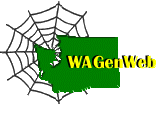Pioneer life in the Benton Co. WA area
Old Dental Car was Unique/Brandy was only Painkiller
By BURTON 0. LUM
Tri-City Pioneer
Tri-City Herald, Sunday, 22 October 1961
Regular trains, both freight and passenger were scheduled over the Northern Pacific Railway between Pasco and Seattle. As soon as the switchback at Stampede Pass had been completed and the Palmer cutoff constructed then all manner of new services were brought to the pioneers of the Tri-City area. One of the most unique was the dental car. It was a remodeled, obsolete dining car. The dingy green exterior of the car was repainted a brilliant pink and on each side of the car in vandyke brown was lettered DENTAL CAR. The dentist and his family lived in the quarters formerly used by the dining car employes.
The dining space was turned into a dental office with its dental chair, foot pedal-powered drill and other equipment. This car would be switched to the end of the different side tracks where it would remain for a week.
Previous to the tour of the dental car, and advance man on horseback contacted the pioneer settlers. He gave out pamphlets and explained the services and gave them the time and location that the car would be available. He also secured the postal addresses of the pioneers. The car covered its territory every six months.
The dental practice in these early days required the patient to chew his food with his hums for a period of six months after the extractions. This hardened the gums before the impressions were taken for the dentures. Many of the pioneers’ whiskers were plastered and their windpipes clogged with the plaster of Paris used by the dentist in making the impressions. There was no running water in a fountain in which to expectorate, nothing but a tin cup of water and an old fashioned high brass saloon spittoon in which to spit.
The puling of the teeth was perhaps the most painful of all the dental operations of these pioneer days. The patients were strapped on the dental chairs where could be raised, lowered and tilted, quite similar to the modern barber chair. No novacaine or gum deadener of any kind was used. The dentist placed his forceps on the patient’s tooth and in the midst of curses of pain and gasps of anguish, yanked out the tooth. He proudly showed it to his patient and dropped it in the spittoon. Then, releasing the patient’s head, the chair was lifted up. The patient was given a tin cup of water to gargle his throat, wash out his mouth and spit in the spittoon. If the patient showed signs of weakening, he was given a shot of brandy from the dentist’s bottle to revive him. If he received too many revivings and was becoming intoxicated, the dentist sprinkled his face with cold water to keep him from passing out.
The filling of the teeth was almost as painful as the extractions. The dentist stood on one foot and with the other foot pedaled the power for his drill. In this awkward position his drill struck the gums nearly as often as the cavity. The fillings were gold, silver and porcelain. The dentist scraped the tartar from the teeth with a sharp instrument without deadening the gums. A supply of toothbrushes, tooth powder and mouth washes were carried and sold to patients.
The headquarters of the company that owned and operated the dental car was on Puget Sound. If a patient cracked his plate he could mail it for repair to the headquarters. Some of the treatments were a little rugged but the dental car was a great boon to the pioneers. They were a group of rugged people and were not bothered.
Dentistry never worried the buckeroo. His toothbrush was his index finger. He stuck this finger in his mouth and then into the ashes of his camp fire, massaged his gums and teeth, wiped his finger on the fringe of his chaps, rinsed out his mouth with hot coffee, spat it on the ground and his oral hygiene was done for the day.
Return to Index of Burton Lum Articles

